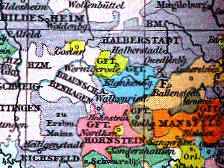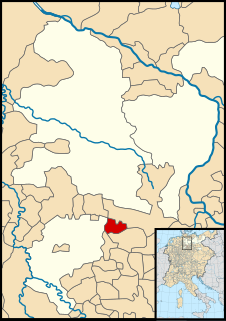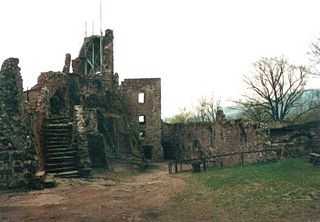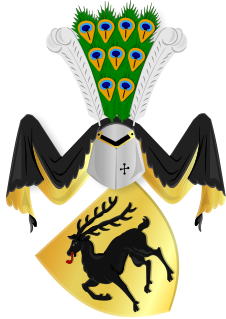
Wernigerode is a town in the district of Harz, Saxony-Anhalt, Germany. Until 2007, it was the capital of the district of Wernigerode. Its population was 35,041 in 2012.
The County of Stolberg-Wernigerode was a county of the Holy Roman Empire located in the Harz region around Wernigerode, now part of Saxony-Anhalt, Germany. It was ruled by a branch of the House of Stolberg.
The County of Stolberg-Rossla was a county of the Holy Roman Empire. Its capital was Rossla, now in Saxony-Anhalt, Germany. It was owned and ruled by a branch of the House of Stolberg from 1341 until 1803.

Stolberg-Stolberg was a county of the Holy Roman Empire located in the southern Harz region. Its capital was the town of Stolberg, now in Saxony-Anhalt, Germany. It was ruled by a branch of the House of Stolberg.

Stolberg (help·info) is a town and a former municipality in the district of Mansfeld-Südharz, in the German State of Saxony-Anhalt, Germany. It is situated in the southern part of the Harz mountains, about 27 kilometres (17 mi) west of Sangerhausen, and 13 km (8.1 mi) northeast of Nordhausen. Since 1 September 2010, it has been part of the municipality of Südharz.

The County of Blankenburg was a state of the Holy Roman Empire. Its capital was Blankenburg, it was located in and near the Harz mountains.

The County of Wernigerode was a state of the Holy Roman Empire which arose in the Harzgau region of the former Duchy of Saxony, at the northern foot of the Harz mountain range. The comital residence was at Wernigerode, now part of Saxony-Anhalt, Germany. The county was ruled by a branch of the House of Stolberg from 1429 until its mediatization to the Kingdom of Prussia in 1806. Nevertheless, the county remained in existence - with one short interruption - until the dissolution of the Kingdom of Prussia in 1918.

Wernigerode Castle is a schloss located in the Harz mountains above the town of Wernigerode in Saxony-Anhalt, Germany. The present-day building, finished in the late 19th century, is similar in style to Schloss Neuschwanstein, though its foundations are much older. It is open to the public and one of the most frequently visited in Saxony-Anhalt.

Anhalt Castle is a ruined medieval fortification near the town of Harzgerode in Saxony-Anhalt, Germany.

Hohnstein Castle is one of the largest and best-preserved castle ruins in Germany and is located near Neustadt in the vicinity of Nordhausen in Thuringia.

Heinrichsberg Castle is a ruin north of Mägdesprung in the borough of Harzgerode in central Germany. It is not far from the B 185 federal road in the district of Harz in the state of Saxony-Anhalt.

Hohnstein Castle is a medieval castle in the village of the same name, Hohnstein in Saxon Switzerland in the Free State of Sachsen in East Germany.

Christian Ernest, Count of Stolberg-Wernigerode, was a German politician and a member of the House of Stolberg. From 1710 to 1771 he governed County of Wernigerode in the Harz mountains, which in 1714 became a dependency of Brandenburg-Prussia.

The princes and counts of Stolberg are members of a large German dynasty of the former Holy Roman Empire's higher aristocracy. They played a significant role in feudal Germany's history and, as a mediatized dynasty, enjoyed princely privileges until the collapse of the German Empire in 1918. The house has numerous branches.

Sophienhof is a village in the municipality of Ilfeld in the district of Nordhausen in the German federal state of Thuringia.
Count Bodo VII of Stolberg and Wernigerode was a German nobleman. He ruled the counties of Stolberg in the southern Harz and Wernigerode in the northern Harz.
Ernest, Count of Stolberg-Ilsenburg was a German nobleman. He was an imperial count and the ruling Count of Königstein, Rochefort, Wernigerode and Hohnstein, as well as Lord of Eppstein, Münzenberg, Breuberg, Agimont, Lohra and Klettenberg

Old Falkenstein Castle in the Harz Mountains of Germany is the castle site or burgstall of a high medieval hill castle. It lies on the territory of Falkenstein/Harz in the state of Saxony-Anhalt in the district of Harz. It was built in the 11th century A.D. and destroyed in 1115.
Mansfeld Land is a region in the southwestern corner of the German state of Saxony-Anhalt. The region derives its name from the counts of Mansfeld, who ruled this region for about 1,000 years.















